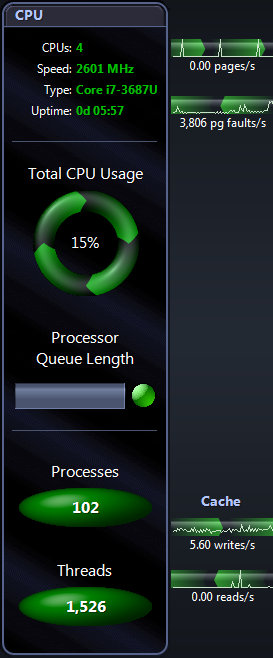CPU Panel
CPU Panel
|
|
|
The CPU panel shows processor and load information for the Windows system: CPUs — The number of processors installed on the target system. Speed — The speed of the processor(s) installed on the target system. Type — The type of processor(s) installed on the target system (Intel Pentium III, for example). Uptime — The length of time since Windows was last booted (started). Total CPU Usage — This spinner represents the total amount of CPU being used on the machine being diagnosed. It includes CPU consumed by all windows processes. This component spins faster as CPU demands increase. Processor Queue Length — Shows the average number of threads (program execution units) that are waiting to run on each processor. A sustained average greater than three can indicate processor congestion. Processes — Shows the number of applications and services that are currently active on the system. Threads — Shows the number of threads currently active in all processes. A thread is a running portion of the owning process. Every process has at least one thread.
Page Outs per second — Shows the number of memory pages per second that are being written to disk from physical memory, in order to free up physical memory. The memory pages are checked first to see if they have been modified - if no modification has taken place, they are discarded. Page Faults per second — This is a measure of the number of page faults per second on the system. This value includes soft faults and hard faults. A page fault occurs when a process requires code or data that is not in its space in physical memory. A soft fault is when a memory page is not in the physical memory of the process, but resides in another segment of physical memory. A hard fault occurs when a memory page is not in the physical memory of the process, and has to be brought from disk.
Cache Writes — This flow shows the rate at which cache pages are written to disk from memory, in order to satisfy a write through request (an application request to not write information to cache, but directly to disk) or a cache flush (a regular writing of data from the write-cache to disk). Cache Reads — Shows the rate at which cache pages are read by applications from memory.
|
The flows between the CPU panel and the Memory panel represent paging information between CPU and memory on the Windows system. The flows include the number of memory pages written out and read in to memory per second.

